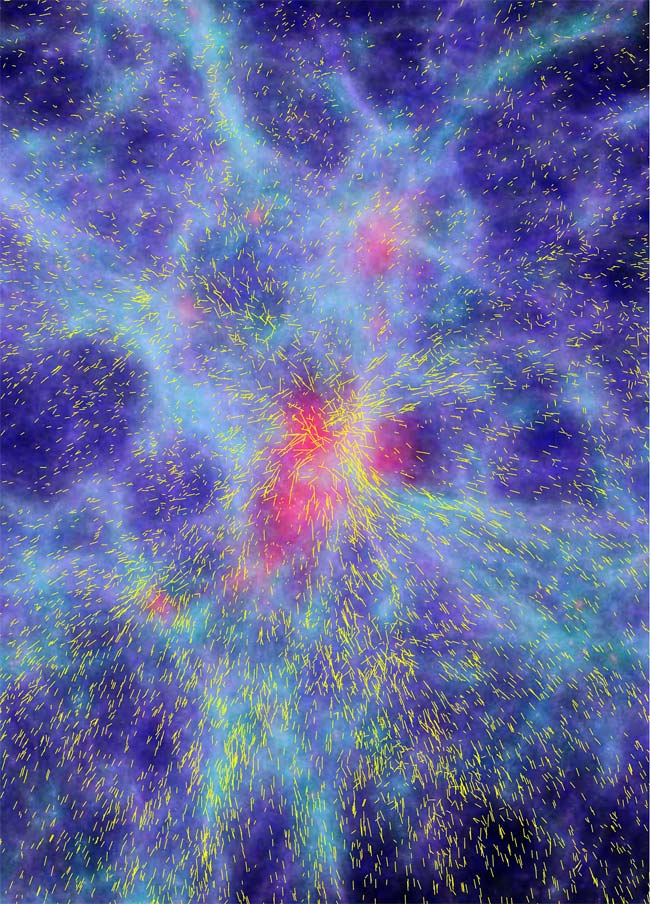After Big Bang Came Moment of Pure Chaos, Study Finds

The universe was in chaos after the Big Bang kick-started the cosmos, a new study suggests.
While one might expect the explosion that began the universe to wreak some havoc, scientists mean something very specific when they refer to chaos. In a chaotic system, small changes can cause large-scale effects. A commonly cited example is the "butterfly effect" — the idea that a butterfly beating its wing in Brazil can bring about a tornado in Texas.
While past studies have suggested chaos reigned during the infancy of our universe, the new research offers what scientists say is iron-clad argument for the case.
"The general result of this paper is that, contrary to what some previous studies have suggested, different observers would still agree about the chaotic nature of the universe," study leader Adilson Motter told SPACE.com. "Now we establish once and for all that it is chaotic."
Universal chaos? Who's asking
Previous probes into whether the nascent universe was chaotic have returned varying results. Some studies suggested that the answer depends on an observer's coordinates — a person at rest in a certain time and place might make different measurements than another who was in motion.
"The problem is ultimately related to the fact that different relativistic observers tend to perceive time differently. It means,in particular, that different scientists studying the same problem would conclude different things," said Motter, who is a physicist at Chicago's Northwestern University.
Breaking space news, the latest updates on rocket launches, skywatching events and more!
But new calculations by Motter and Katrin Gelfert of Brazil's Federal University of Rio de Janeiro prove that this property of the universe is absolute regardless of an observer's relativistic coordinates, Motter stated.That determination is based on applying Motter's calculations to the latest cosmological models of the universe. If those models prove inaccurate, then the universe may turn out not to have been born in chaos, he cautioned. But all observers will agree on that result as well,according to the new findings.
"The main result is the possibility of a universal definition of chaos, i.e., a definition that doesn't depend of the observer," wrote physicist Alberto Saa of Brazil's State University of Campinas, who was not involved in the research. "This is a longstanding problem."
A fraction of a second
According to the new study, chaos in our universe would have started ruling the realm about 10 to the minus 43 seconds (or 0.0000000000000000000000000000000000000000001 seconds) after the Big Bang. And it would have lasted only a very brief time: at least 10 to the minus 36 seconds in duration.
During this time the universe was expanding from its tiny, hot and dense beginnings. At any given time, scientists think, two of its spatial dimensions might have been expanding, while the third was contracting.
And this expansion, like the universe itself, was most likely chaotic, according to the new study.
"If you change just a little bit one of the contractions, then you'd have an entirely different sequence of expansions and contractions," Motter explained.
This period of the early universe is not well understood.Some theories propose that this early chaotic stage was followed by a period of rapid expansion called inflation, when the universe doubled in size more than 100 times within a fraction of a second.
Motter and Gelfert detailed their findings in a recent issue of the journal Communications in Mathematical Physics.
Big Crunch?
While our universe is no longer chaotic, it may return to that state if it experiences a hypothetical Big Crunch.
Some cosmological models predict that the universe will continue expanding forever, or that it will gradually slow down. But it's also possible that it will expand, and then reverse the process and start contracting.
The end result would be a Big Crunch, akin to the Big Bang but in reverse. If that happens, the end of the universe — just like its beginning — will be anything but calm, researchers said.
"It would be interesting if the universe were going to collapse again," Motter said. "In the context of our study, we can ask the question of whether this re-collapse is going to be a chaotic processor not. It would most likely be chaotic."

Clara Moskowitz is a science and space writer who joined the Space.com team in 2008 and served as Assistant Managing Editor from 2011 to 2013. Clara has a bachelor's degree in astronomy and physics from Wesleyan University, and a graduate certificate in science writing from the University of California, Santa Cruz. She covers everything from astronomy to human spaceflight and once aced a NASTAR suborbital spaceflight training program for space missions. Clara is currently Associate Editor of Scientific American. To see her latest project is, follow Clara on Twitter.
